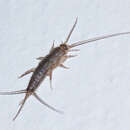en
names in breadcrumbs


The firebrat (Thermobia domestica, sometimes listed as Thermophila furnorum) is a small insect (typically 1–1.5cm) similar to the Silverfish, both in the order Thysanura.
Firebrats prefer higher temperatures and require some humidity, and can be found in bakeries and near boilers or furnaces. They feed on a wide variety of carbohydrates and starches that are also protein sources such as dog food, flour and book bindings. They are distributed throughout most parts of the world and are normally found outdoors under rocks, leaf litter, and in similar environments, but are also often found indoors where they are considered pests. They do not cause major damage, but they can contaminate food, damage paper goods, and stain clothing. Otherwise they are mostly harmless.
At 11⁄2 to 41⁄2 months of age the female firebrat begins laying eggs if the temperature is right (32–41°C or 90–106°F). It may lay up to 6000 eggs in a lifetime of about 3–5 years. After incubation (12–13 days), the nymphs hatch. They may reach maturity in as little as 2–4 months, resulting in several generations each year.
The firebrat (Thermobia domestica) is a small insect (typically 1–1.5 cm), in the order Zygentoma.[1]
Firebrats prefer relatively warm temperatures (36–39 °C) and require some humidity.[2] They are commonly found indoors near heat sources such as furnaces and boilers. They feed on a wide variety of carbohydrates and starches that are also protein sources such as dog food, flour and book bindings. They are distributed throughout most parts of the world and are normally found outdoors under rocks, leaf litter, and in similar environments, but are also often found indoors where they are considered pests. They do not cause major damage, but they can contaminate food, damage paper goods, and stain clothing. Otherwise they are mostly harmless.
Firebrats utilize pheromones to lead other firebrats to attract one another and congregate. To maintain a group, firebrats must remain in contact with one another (Tremblay MN & Gries G, 2003).
At 1.5 to 4.5 months of age the female firebrat begins laying eggs if the temperature is right (32–41 °C or 90–106 °F). It may lay up to 6000 eggs in a lifetime of about 3–5 years. After incubation (12–13 days), the nymphs hatch. They may reach maturity in as little as 2–4 months, resulting in several generations each year.
The sequential changes occurring during the prophase I stage of meiosis in T. domestica ovaries have been described in detail.[3]
The firebrat (Thermobia domestica) is a small insect (typically 1–1.5 cm), in the order Zygentoma.